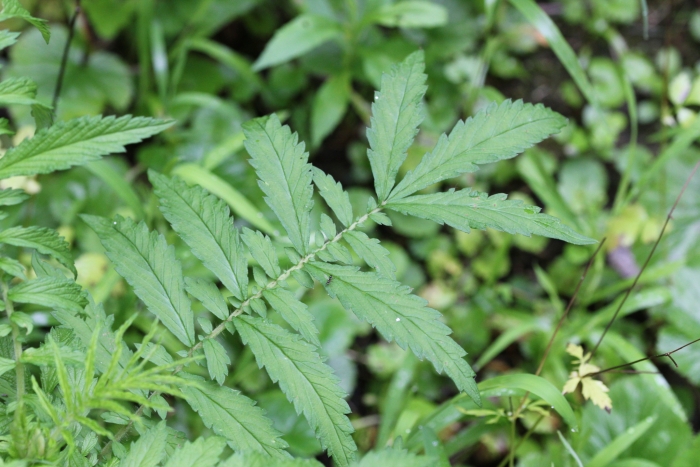Small-Flowered Agrimony
(Agrimonia parviflora)
Small-Flowered Agrimony (Agrimonia parviflora)
/
/

Quinten Wiegersma
CC BY 4.0
Image By:
Quinten Wiegersma
Recorded By:
Copyright:
CC BY 4.0
Copyright Notice:
Photo by: Quinten Wiegersma | License Type: CC BY 4.0 | License URL: http://creativecommons.org/licenses/by/4.0/ | Rights Holder: Quinten Wiegersma | Publisher: iNaturalist | Date Created: 2021-06-26T08:02:36-07:00 |

























Estimated Native Range
Summary
Agrimonia parviflora, commonly known as small-flowered agrimony, is a perennial herb native to a variety of habitats including open woodlands, forest edges, and meadows across North America. It can grow up to 6 feet tall and has pinnately compound leaves with serrated leaflets. From June to September, it produces small, yellow, five-petaled flowers arranged in slender, spike-like racemes, which are moderately showy. The fruit is a bur-like achene that can cling to fur and clothing, aiding in seed dispersal.
Small-flowered agrimony is valued for its historical medicinal uses by Native Americans, who utilized it for various ailments. Today, it is appreciated in naturalistic plantings and wildflower gardens for its wildlife benefits, attracting pollinators such as bees and butterflies. It is relatively low-maintenance, preferring full sun to partial shade and tolerating a range of soil types, though it thrives in well-drained loamy soils. While not commonly used in formal garden settings, it can be an interesting addition to herb gardens or used for natural erosion control on slopes. It is not known to have significant disease or pest issues, but it can spread somewhat aggressively in favorable conditions.CC BY-SA 4.0
Small-flowered agrimony is valued for its historical medicinal uses by Native Americans, who utilized it for various ailments. Today, it is appreciated in naturalistic plantings and wildflower gardens for its wildlife benefits, attracting pollinators such as bees and butterflies. It is relatively low-maintenance, preferring full sun to partial shade and tolerating a range of soil types, though it thrives in well-drained loamy soils. While not commonly used in formal garden settings, it can be an interesting addition to herb gardens or used for natural erosion control on slopes. It is not known to have significant disease or pest issues, but it can spread somewhat aggressively in favorable conditions.CC BY-SA 4.0
Plant Description
- Plant Type: Herb
- Height: 1-3.9 feet
- Width: 1-2 feet
- Growth Rate: Rapid
- Flower Color: Yellow
- Flowering Season: Summer, Fall
- Leaf Retention: Deciduous
Growth Requirements
- Sun: Full Sun, Part Shade
- Water: High
- Drainage: Fast, Medium, Slow
Common Uses
Bee Garden, Bird Garden, Butterfly Garden, Edible*Disclaimer: Easyscape's listed plant edibility is for informational use. Always verify the safety and proper identification of any plant before consumption., Low Maintenance
Natural Habitat
Native to open woodlands, forest edges, and meadows across North America
Other Names
Common Names: Harvestlice Agrimony, Swamp Agrimony, Manyflowered Groovebur, Many-Flowered Grooveburr, Small-Flowered Agrimony, Southern Agrimony
Scientific Names: , Agrimonia parviflora, Agrimonia eupatoria var. parviflora, Agrimonia eupatoria var. suaveolens, Agrimonia polyphylla, Agrimonia serrifolia, Agrimonia suaveolens, Eupatorium parviflorum,
GBIF Accepted Name: